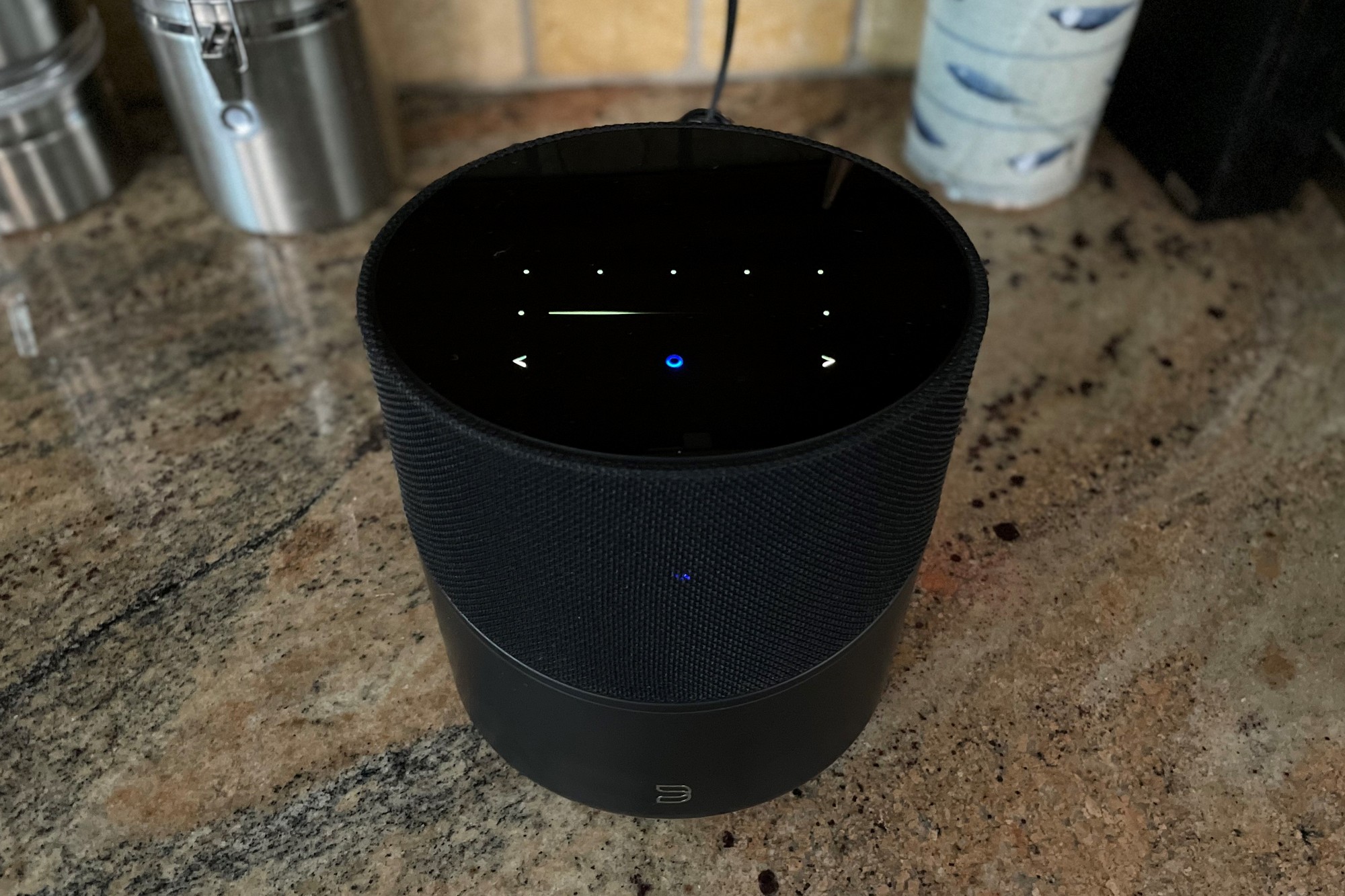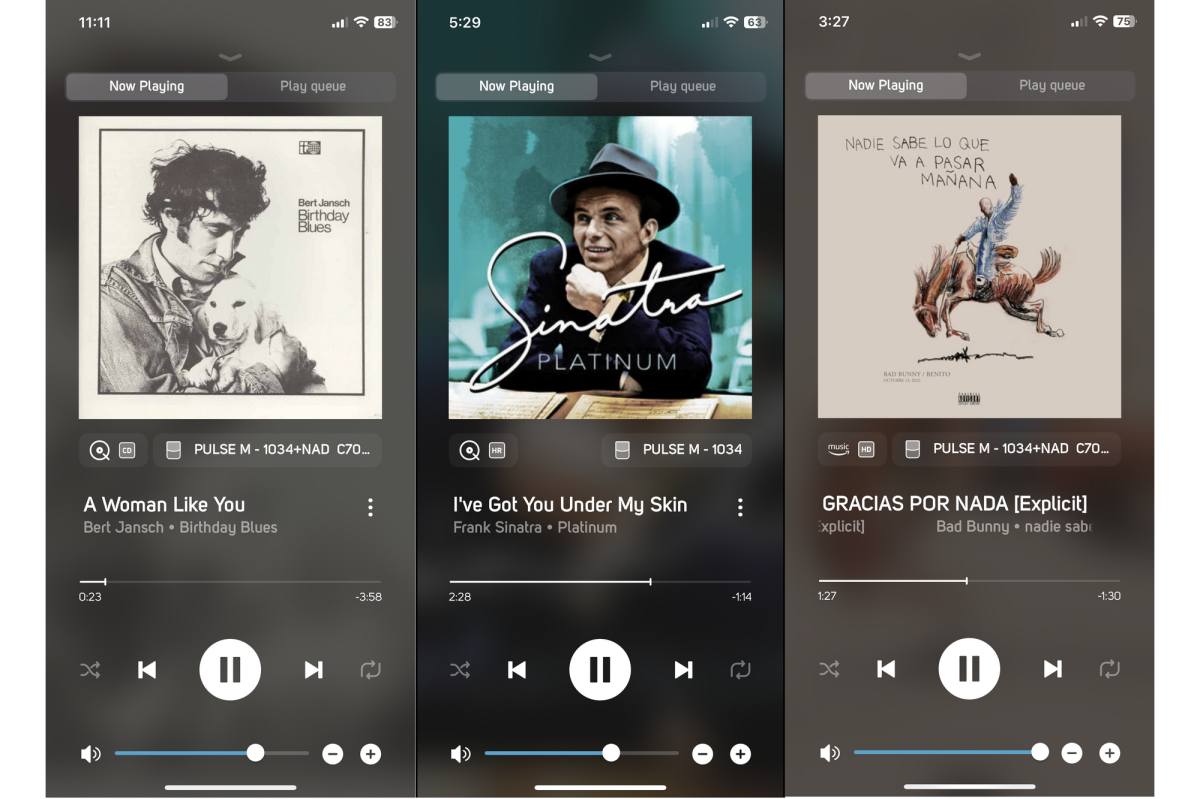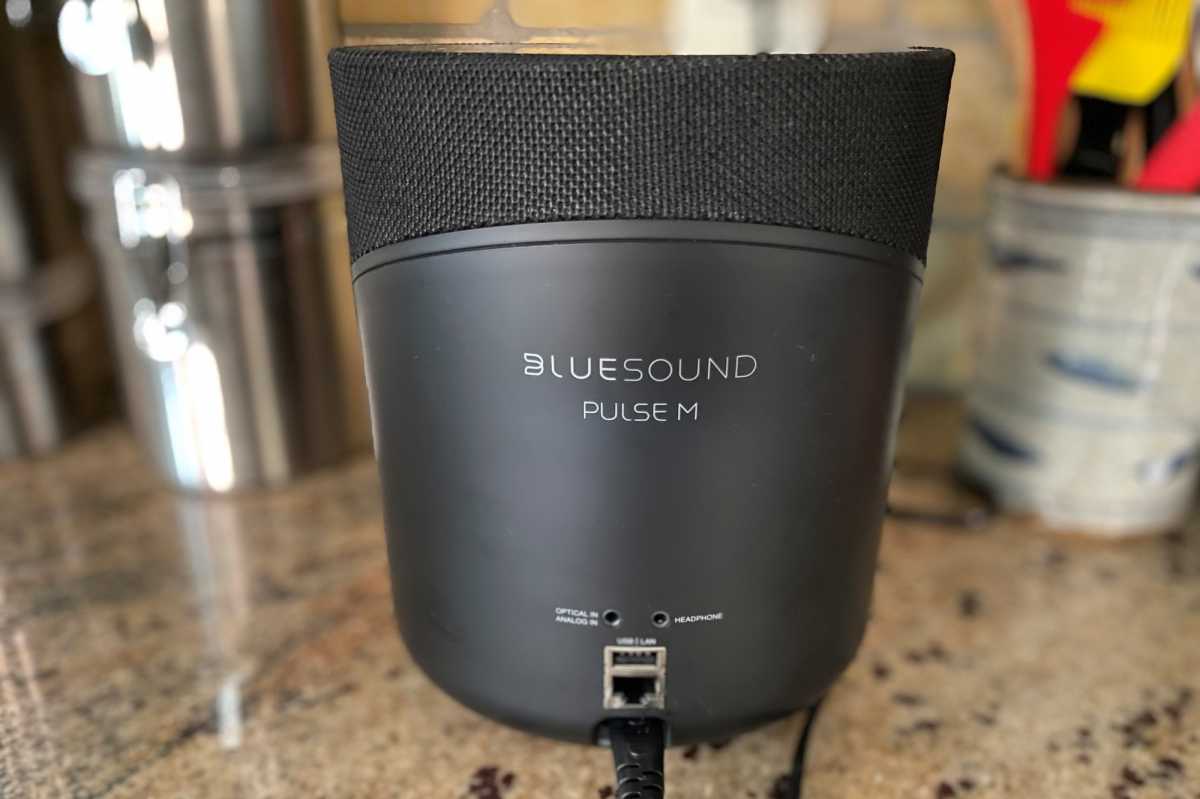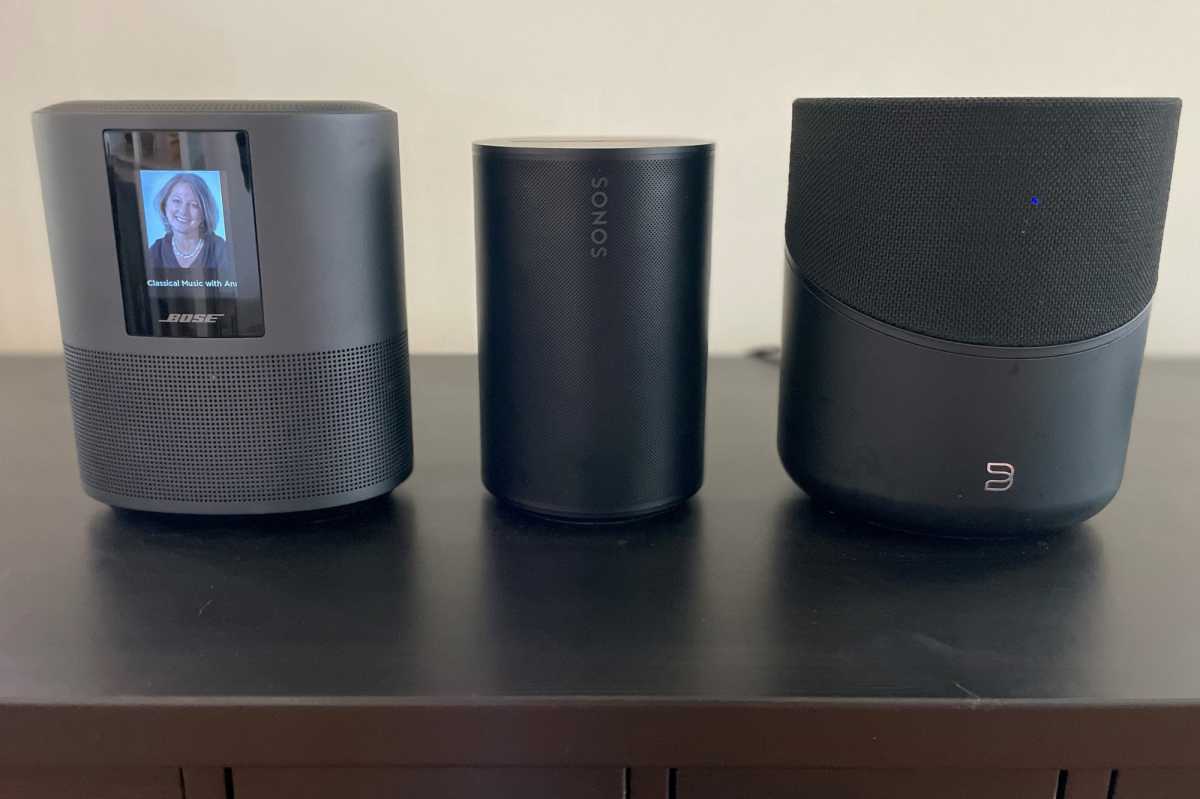Expert’s Rating
Pros
- Stylish appearance and small footprint
- Runs on the excellent BluOS 4.0 platform
- Touch controls kickstart your faves
- Can get very loud
Cons
- Undynamic musical reproduction
- Lacks onboard voice control
- Glass touch screen is a fingerprint magnet
Our Verdict
Listeners with other BluOS components who are looking to stream music for background listening in secondary rooms–the kitchen or home office, for example–will enjoy this speaker, but it’s not a strong entry point to the ecosystem.
Price When Reviewed
$399.00
Best Prices Today: Bluesound Pulse M
$399.00

$399.99
The Bluesound Pulse M wireless speaker presents a glass-half-full vs. glass-half empty predicament.
The BluOS multi-room audio platform it runs on is capable of transmitting sizzling ultra-hi-res performances, as evidenced by such hardware as the $599 Bluesound Node Audio player and the $1,499 NAD C700 Streaming Amplifier. The good news is that the $399 Pulse M not only costs less than either of those components, but it also has integrated speakers—you don’t need to buy anything else. The bad news is that its audio performance doesn’t come anywhere close to those components when they’re paired with speakers of comparable quality.
On the other hand, listeners looking to add BluOS components to rooms where space is at a premium and background music is valued over critical listening sessions—in the kitchen or the home office, for example—The Pulse M will deliver in upper mid-fi fashion. It’s also as easy to use—either with its onboard controls or with the app accessing the freshly polished BluOS 4.0—as it is to look at.
For whole-house jammin’ and whistle-while-you-work ambient listening, The Bluesound Pulse M is more than a bit of all right.
Design & build


The 5.5-pound oval Pulse M demands minimal shelf space, measuring just 8 inches high with a 6.7 x 5.9-inch footprint. Similar in design to the $249 Sonos Era 100 and the $379 Bose Home Speaker 500, the Pulse M features a 50-watt Class D amplifier powering an upward-firing, circularly diffused 5.25-inch woofer. A separate Class D amplifier sends 15 watts each to a pair of outward-firing .75-inch tweeters, set at 45-degree angles to deliver widely dispersed—but barely stereo—sound. Of the three single-cabinet speakers I just mentioned, the Bose delivers the best stereo imaging.
While the Bluesound Pulse M can be controlled with an Alexa-powered smart speaker, it is not itself a smart speaker. We think these are the best smart speakers.
On paper, the rest of the Pulse M’s specs look terrific. Like all things BluOS, it can pull down ultra-high-res content at 16- or 24-bit depths and with sample rates up to 192kHz from such premium content providers as Amazon, Qobuz, and Tidal–including the latter’s “Master” grade streams encoded in MQA. (Bluesound’s parent company Lenbrook acquired MQA Limited in September).
BluOS also supports almost all the other service providers you might crave, including Deezer, Napster, nugs.net, Pandora, Presto Music, Spotify; plus, radio services including Calm Radio, iHeartRadio, Radio Paradise (which also offers MQA streams), SiriusXM, TuneIn, and 15 others. If you have a paid Roon subscription and a Roon Core on your network, you can control the Pulse M with that software, too.

The tracks for my listening test ranged from vintage British folk (Bert Jansch) and big-band swinger Frank Sinatra to Latin hip hop superstar Bad Bunny and more.
Jonathan Takiff/Foundry
Apple Music is missing here, but can be brought home via AirPlay 2. Other content can be yours via Pulse M’s Bluetooth 5.0 radio, with support for the aptX HD codec. Not incidentally, operating this speaker in multi-room sharing mode with other BluOS components does not spark a step-down in resolution. Compare that to the Sonos Era 300, which loses its Dolby Atmos decoding skill when sharing a stream with other Sonos devices.
Wired connection options on the back include a USB-A input (for streaming music stored on a thumb drive) stacked atop an RJ45 port for hardwired network connectivity if its dual-band Wi-Fi 5 wireless option doesn’t suffice. There’s also a combo Toslink digital optical/analog stereo 3.5mm input (with supplied adapter) and a 3.5mm headphone jack. (Good-quality wireless headphone listening is possible via 2-way Bluetooth.)
A smokey glass top control panel is the sexiest part of this minimalist package. A proximity sensor lights it up as your hand approaches, revealing capacitive touch controls: a volume slider; next- and previous-track; play/pause; and five dots that can programmed in the BluOS app as presets for favorite radio stations, playlists, or albums. If your Pulse M is grouped (in the app) with other BluOS players, tapping a preset here also gets the other music makers humming along in perfect sync.

The Pulse M has an onboard ethernet port if you like the reassurance a wired network connection can provide. There’s also combo Toslink/3.5mm analog input and a 3.5mm headphone ouput out back.
Jonathan Takiff/Foundry
I’m a big fan of preset buttons on streaming devices: Bose has them on even its least expensive smart speaker, the Home Speaker 300; Grace Digital has them on some models, including its Mondo Classic; as does SVS in its Prime Wireless line. But not Sonos.
If your music box is close at hand, being able to jump-start the show with a tap is a lot faster than announcing your radio station request to a voice assistant or digging into the app, which is the fallback position on all streaming speakers. Voice activation is how Sonos rocks, of course, and it’s an option on Bose smart speakers. The Pulse M doesn’t have an onboard mic, so you’ll need to connect a separate Alexa-compatible device that’s nearby, and that process is complicated.
Audio performance
I predict four out of five doctors would recommend a Pulse M—for their waiting rooms. It takes me back to the table radio playing soothing classical or easy-listening music in my pediatrician’s office. The kind of sonic wallpaper intended to keep a little kid calm before the mean-old doc stabbed you with a dreaded needle.
To be honest, I had the Pulse M in my home office for six months before finally getting around to formally reviewing it. At first, I rationalized putting off the writing to let its drivers break in; later, the promise of a major upgrade to the BluOS platform gave me reason to pause. I hoped the new foundation would improve this speaker’s underwhelming musical personality—more bland than outright bad.
Both stalling tactics worked, to a degree. With time and use, the bottom-end response grew a tad deeper and more dynamic. This made it easier to distinguish between, say, electric and stand-up acoustic bass. The BluOS 4.0 update, meanwhile, improved the Pulse M’s digital signal processing option, dubbed Front Row. Tapping the FR activator icon now pushes forward the rig’s otherwise reticent, listless midrange and considerably sharpens/brightens its otherwise blunt high-end.

Brothers from other mothers: I couldn’t help but compare the $399 Bluesound Pulse M (right) with the similarly configured $379 Bose Home Speaker 500 (left) and the $249 Sonos ERA 100 (center).
Jonathan Takiff/Foundry
Curiously, Front Row offers a far more intense, turbo-charged persona than you can achieve by just cranking the BluOS tone controls to the max. The FR EQ enhancement works reasonably well with a variety of music, but is not adjustable and is not perfect. Like Bose’s Immersive Audio digital processing for its new Ultra headphones (in-ear and over-ear), Bluesound’s Front Row sparks already peaking or echo-enhanced vocals and instruments to sizzle like bacon in the pan at medium-hot through scorching volume levels, as neo-soulsters Black Pumas proved in an audition of “More Than a Love Song” and global hip hop icon Bad Bunny scored on his newbie “Gracias Por Nada.”
Dynamics also seem a tad compressed with Front Row activated. But if you like it loud, you probably won’t notice, as the Pulse M still howls to 96 decibels (as measured on my dB meter). That output is comparable to the Bose Home Speaker 500 (which has a more natural and appealing high end), and it’s 10 decibels louder than the Sonos Era 100. For this test, I used the same symphonic material–Robert Schumann’s mighty “‘Spring’ Symphony No.1”–streamed from New York’s WQXR, via TuneIn, to all three speakers simultaneously.
While less suited for a big room, the Era 100’s bass response was better articulated and its overall sound portrayal the most refined of these three. It came the closest to delivering a you-are-there, concert-hall listening experience. I also found the Sonos most revealing with brassy gems from the new Frank Sinatra collection Platinum, and on a classic, minimalist (voice, acoustic guitar, standup bass, and drums) track I didn’t mind comparing over and over: the sinewy “A Woman Like You” from British raga-folk innovator Bert Jansch’s remastered Birthday Blues set.

You can either tweak the Pulse-M’s tone controls or lock in its Front Row EQ, but not both simultaneously. Replay-gain modifications are available with either. Track gain activation is slightly brightening.
Jonathan Takiff/Foundry
Should you buy a Bluesound Pulse M?
While its looks are lovely and operation is easy, the Pulse M is not a great entry-level component that will motivate you to fill your abode with compatible higher-end gear. It’s the underachiever of the BluOS family, premium-priced, but incapable of delivering the sonic quality the platform is capable of.
If you’re already firmly entrenched in the BluOS ecosystem, on the other hand, this streaming speaker’s ergonomics, small footprint, and easy-to-live with nature will serve you and yours well enough. For whole-house jammin’ and whistle-while-you-work ambient listening, it’s more than a bit of all right.

